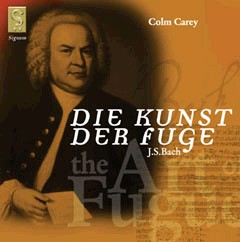|
|
World music CD DVD shop and Classic distribution
|
|
|
|
| BACH, Johann Sebastian (1685-1750) | | | Die Junst der Fuge | | | 1. | Contrapunctus i | 3:46 | | | 2. | Contrapunctus ii | 3:07 | | | 3. | Contrapunctus iii | 4:57 | | | 4. | Contrapunctus iv | 4:49 | | | 5. | Contrapunctus v | 3:02 | | | 6. | Contrapunctus vi | 5:38 | | | 7. | Contrapunctus vii | 4:10 | | | 8. | Contrapunctus viii | 7:18 | | | 9. | Contrapunctus ix | 3:12 | | | 10. | Contrapunctus x | 7:16 | | | 11. | Contrapunctus xi | 7:06 | | | 12. | Contrapunctus xii | 8:41 | | Music Web - June 2002
The Art of Fugue remains a mystery. Bach specified no instrumentation; Schweitzer described it as ‘purely theoretical’. No composer has ever matched it in contrapuntal ingenuity or the unfulfilled promise of the great, final four-subject fugue tailing away incomplete at Bach’s Death.
For myself, I believe that Bach intended the work for didactic purposes but would certainly have expected the work to have been performable and performed. As for which instrument or instruments it should be played on or by … well ‘you pays ya' money and takes ya’ choice’. I am not sure that it really matters. You can have harpsichord, or piano (Glenn Gould is interesting) or organ as here, or as instrumental chamber music. You could for example decide on the Keller Quartet (ECM 457 849-2) or intriguingly for Saxophone quartet on CPO, which is, I admit, a somewhat curious choice, or the Amsterdam Bach soloists on modern instruments (Ottavo C48503). What about Robert Hill on Hänssler (Cd 92.184) playing the harpsichord or the great unsurpassable Gustav Leonhardt (special Gustav Leonhardt edition) Yet... yet… yet the organ, despite very scholastic viewpoints, does seem to be appropriate and helpful for the listener.
In the Henle Verlag edition of the score the harpsichordist Davitt Moroney comments: for "The Art of Fugue we now know that Bach had the harpsichord predominantly in mind" because "Bach used open score notation … as was conventional in intricate contrapuntal music by Frescobaldi, Froberger and others." This type of notation does not prove that this is organ music, indeed Bach used open notation for harpsichord works at other periods.
In the booklet notes Colm Carey remarks: "the harpsichord can bring out intimacy in the work … On the other hand, the organ can actually achieve this as well in spite of the fact that it promptly summons to mind oceans of vast sounds filling large spaces." He adds: "Indeed a small organ in a modestly sized church fulfils the role remarkable well".
It is true therefore that the organ can offer "colour and drama … and (he says later) it can achieve subtlety of touch and articulation … and bring another dimension to the work through the spectrum of sound colours and dynamic variation".
Looking at pages 16, 17 and 18 in the booklet, the organ is described and the registration for each Fugue set out so that the variation of sound spoken of can be clearly understood. One is even told the bar numbers where the registration was altered.
This is an interesting instrument located in the City of London. Sadly I always found the church locked when I have made various attempts to see the instrument. The stops are not in any way ‘English’, for example there is a ‘Baarpijp’ (mercifully probably rarely used here!) and ‘Ruispijp’ of five ranks and a 16-foot Bazuin. The organ’s restoration in 1995 was costly but of tremendous worth. Colm Carey handles it with considerable subtlety and only really lets go in Contrapunctus 12 - the last one.
Incidentally there is considerable debate concerning the numbering of these pieces and the twelfth piece is normally printed as Contrapunctus 14 in many editions as in the Henle Verlag.
I should say at this point that the reason why this is a single CD is because, as he explains in the notes, Carey here only plays the twelve fugues or contrapunctus. The brief Contrapunctus 12, Contrapunctus 13 which Bach arranged into a version for two harpsichords and the four canons are omitted. Other recordings may have these, sometimes interspersed between the fugues. Carey says that playing "the twelve consecutive contrapuncti without the mirror fugues and canons gives the work a real sense of the narrative developing". I completely agree. Nevertheless at over an hour it is a major act of concentration for the listener to take all of these fugues in one go to "experience the narrative". Best to take them in order but in groups of say four. A mini-drama unfolds which can also be gripping, following the related fugue subjects in their various shapes and guises: a counter-subject becoming the fugue subject, the melody heard in augmentation or inversion but all in one key; that of D minor. Does the key make for sameness? I say definitely not. Colm Carey’s registration does continue to build and helps you to follow the contrapuntal argument although there were times when I said ‘come on let’s have some red-blooded passion’.
So, should you purchase this recording? Well I can only say that if you are not an organ fan and you want to get to know the work then I would first try an instrumental version. If you like the harpsichord then try Leonhardt, remembering that Bach was as much harpsichordist as organist and that either medium works in the hands of a sensitive and imagination musician like Colm Carey.
Gary Higginson
|
|

